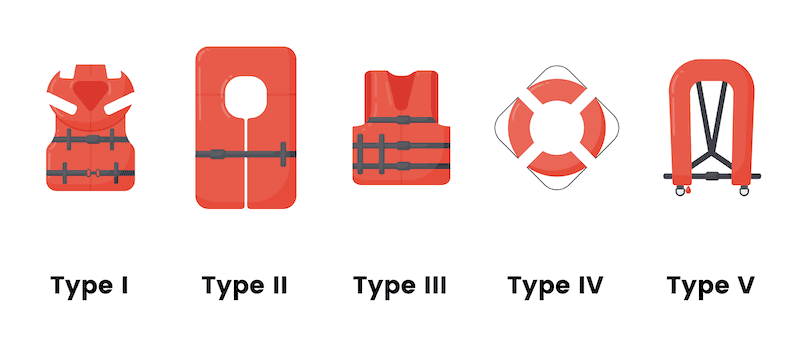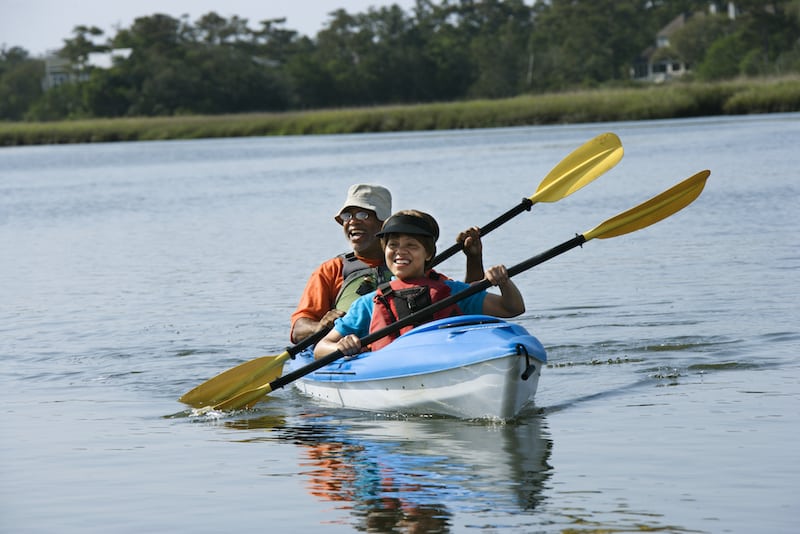Many non-swimmers wonder if they can go kayaking. The risk of a kayak tipping over or a paddler winding up in the water is a very real one. All kayakers should be prepared if it happens, but it’s not the normal course of events. Most paddling happens on peaceful calm days when there is little risk of anyone falling in. You certainly don’t need to be a star swimmer, but you should at least be comfortable in the water.
Is Kayaking Dangerous If You Can’t Swim?

Having fun while kayaking, or any watersport for that matter, is only possible if you are completely honest with yourself. Precisely what do you mean when you say you can’t swim? Swimming laps or treading water for hours aren’t skills that a kayaker has to have. But, on the other hand, if you can’t float on your own in the water—or the thought of doing so fills you with dread—then kayaking probably isn’t for you.
For those who are comfortable in the water but don’t swim very well, kayaking is a great sport to enjoy. Remember, the goal is to go kayaking, not swimming! It’s unlikely that you’ll wind up in the water at all, and if you do, what you need to do is float long enough that you can right the kayak and get back in it. You aren’t swimming to shore and towing your kayak around. All the while, you are wearing a floatation vest to help you float. Your kayak will keep floating, too. And if you pick the right kayak, it’s easy to get back on.
6 Kayaking Tips for Non-Swimmers
Safely kayaking, no matter your swimming experience level, is a matter of learning a few skills, having the right equipment, and making sound decisions regarding where and when to go paddling. Here are six tips to keep you safe on the water.
1. Use a Life Jacket

Life jackets aren’t just a good idea; they’re the law. Kayaks are legally considered vessels (boats) by the US Coast Guard and local marine police. That means you are legally required to have a PFD (personal floatation device, also called a life jacket) on board for every occupant. On a kayak, that usually means that you should be wearing it.
Many experienced swimmers strap their life vests to the deck when paddling in calm water. If you consider yourself a poor swimmer, don’t ever do this. You should wear your life vest at all times while on the water. The best sorts of kayaking life vests are designed for watersports, known as Type III or V PFDs. They provide sufficient flotation to keep you on the surface but also have enough range of movement to be comfortable to wear while paddling.
2. Take Some Kayaking Lessons
One sure-fire way to boost your confidence on the water is to take some kayaking lessons. Lessons let you practice in a controlled environment, and a good instructor should give you the confidence to push yourself a little bit more than you would regularly do. Under their watchful eye, you should be able to practice getting in and out of the boat in the water. Many outfitters have a pool or a protected place where you can use the boat and see what it’s like.
Lessons also provide you with some practice and advice on how not to tip in the first place. You’ll learn some basic bracing strokes and how to handle the paddle. If you’re paddling a sit-in kayak, you’ll learn how to exit the boat and get back in. All of these skills will give you the confidence you need to set out on your own.
Lessons are also an excellent way to get to try out some different types of boats. You’ll be able to compare their characteristics, so you’ll know what sort you want to paddle.
3. Kayak With a Friend

It’s always more fun to tour with a friend; to share the experience with someone else who enjoys it makes it all the more special. Plus, there are many times when kayaking alone isn’t a good idea. Many kayaks are a lot easier to board if you have another paddler to help you on. The assisted entry means that if you go for a dip, you will spend less time in the water and get back on your boat more quickly.
Other paddlers can help you fend off other problems, too. Having another boat nearby means they are there to help out if anything goes wrong. If you’re new to kayaking or a weak swimmer, consider bringing along a more experienced friend. That way, they’ll give you a heads up for places to be more cautious and be able to identify possible problems ahead like swift currents or changing weather.
4. Choose a Stable Kayak
There are many different kayak designs, but for non-swimmers, it’s vital to choose a very stable one. This usually means one that has a wide beam, or width. The wider the beam, the more effort it takes to tip it over. Long and slender kayaks may look nice, but they can be extraordinarily tippy and unstable.
The choice between sit-in or sit-on-top kayak is an important one to consider, too. Both types of boats, if they are well designed, have similar stability characteristics. But it’s much easier to get back onto a sit-on-top model, which is excellent if you want to spend less time in the water. The basic idea of a sit-on-top kayak is that you just pull yourself back on board if you fall off. Most sit-on-tops are designed with stability and ease of use in mind, so they are an excellent choice if you are starting out and are in a warm-water climate.
On the other hand, sit-in models mean a drier ride and are therefore more common in cold climates. With a tight-fitting spray skirt, you’ll need to practice getting in and out of a sit-in kayak a little bit. Should they tip, experienced paddlers can roll themselves back upright in a maneuver called an Eskimo roll. In warm climates or emergencies, it’s still important to be able to calmly slip out of the boat and surface next to it and then re-enter the boat.
It’s hard to generalize what to look for because each kayak is different. Many believe that sit-on-top kayaks are less stable simply because you sit up higher in the boat. This is certainly sometimes true, but not always. In the end, stability comes from many factors in the design, so it’s essential to try out a few boats and see which one feels the most stable.
Stability also needs to be weighed against other considerations. When you first start paddling, you will build confidence in yourself and the boat quickly. It’s best to choose a boat with all-around good performance—it should be stable, yes, but it should also be fun to paddle.
5. Kayak in Calm, Flat water

By far, the biggest thing you can do to ensure that you stay dry during your trip is to make sure that you’ll only be in calm conditions. Kayaking is a hobby that you grow into. As you gain more experience, you can go out in more challenging conditions. But when you first start, you want the experience to be a good one. That means finding a day with no wind and flat calm seas. Pay attention to the tide and currents, too, so you aren’t surprised by a long, tiring paddle home.
Another thing to consider on your first trips is finding some shallow water to play in. There are many places where you can paddle all day in water only a few inches deep. This is a beautiful place to learn because it will be much easier to get back on if you do fall off. Most kayaks only need a few inches to float. Usually, the limiting factor is how deep you can put your paddle in, so water shallower than a foot or so is difficult. If you are mucking around in the shallows, make sure to pay attention to the tides. You don’t want to have to walk home.
6. Check the Weather
The weather dictates any activity on the water. It doesn’t matter your vessel’s size or shape–all boaters need to have a rough idea of what the weather is doing. Things can change with shocking speed out on the water, and the last thing you want to do is get caught in a sudden squall or misjudge the current.
Lakes and shallow bays are often the easiest places to learn. Tides play a significant role in some parts of the world, while they are of no concern in others. Ensure you have a good idea of where you’ll be kayaking and the things you need to watch out for. If you’re new to an area, stop by the local outfitter and chat with them about their favorite trips. Be honest and tell them that you’re new to the area and wondering what you should watch out for.
Conclusion
Nearly everyone can learn to enjoy kayaking. It’s not a swimming sport; it’s a paddling sport. As such, being a star swimmer is never a requirement. So long as you are comfortable around and in the water, kayaking is a blissful way to spend a day on the water.
